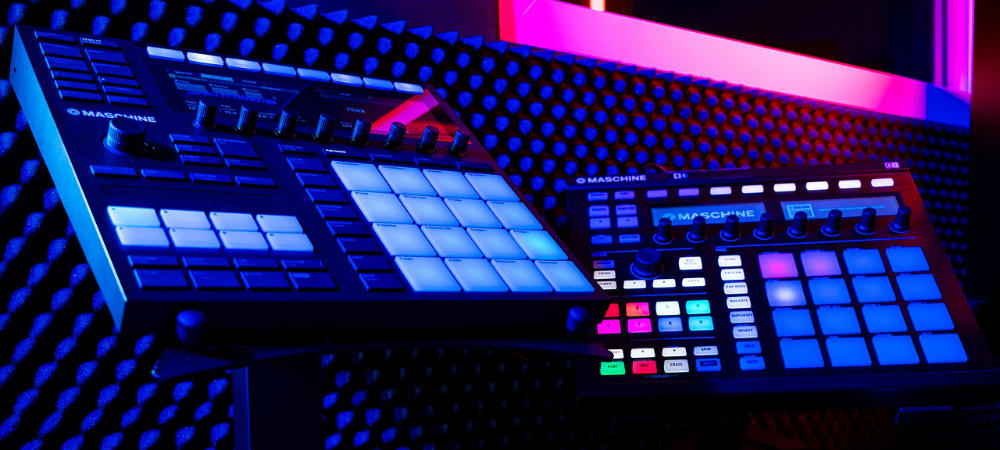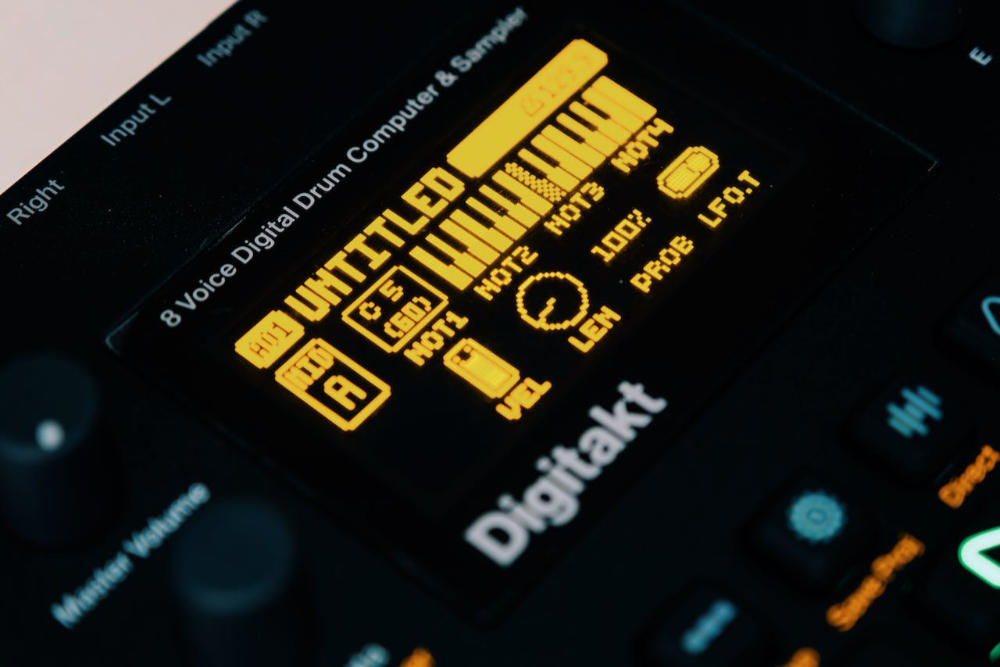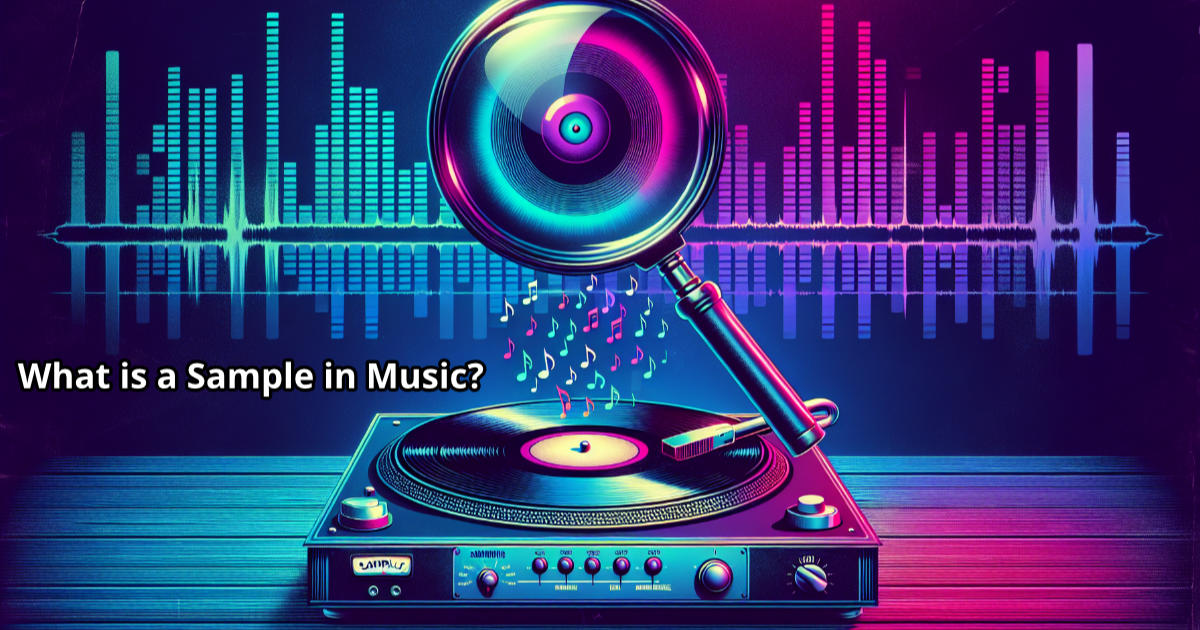Estimated reading time: 13 minutes
Music sampling, broadly speaking, involves taking a piece of music or sound recording and incorporating it into a new track. This technique has transformed the way artists create, allowing them to remix original audio snippets—whether they’re drum breaks, melodies, or vocals—into fresh compositions. It’s a cornerstone of modern music production, impacting genres from hip hop to electronic, and has evolved with technology, from hardware samplers to the digital audio workstations (DAWs) used today.
What is a sample in music? At its core, it’s about reimagining existing sounds, be they a singular kick drum or an entire drum beat, to craft something original. This introduction to the world of sampling music will explore the artistry behind it, delve into its history, and unpack the legal implications, like copyright infringement, that come with it. Through understanding the different types of samples, from drum loops to snippets of speech, and how they’re deployed in music through instruments like samplers, this article aims to demystify the process and its significance in the digital age.
Table of contents
Defining a Music Sample
At its core, music sampling is a multifaceted technique used by artists to breathe new life into existing sounds, creating something entirely unique yet familiar. This process can be broken down into several key components, each playing a crucial role in the transformation of sound.
- Techniques of Sampling:
- Looping: This involves repeating a section of sound continuously. Looping can transform a brief drum beat or vocal snippet into the backbone of a new track.
- Slicing and Splicing: By cutting sound recordings into smaller pieces and rearranging them, artists can construct a new sequence. This technique is pivotal in creating unexpected rhythms or melodies.
- Manipulation: Altering pitch, tempo, and other sonic characteristics allows a sample to fit seamlessly into a new musical context. These adjustments can significantly change the mood or style of the original sound.
- Purpose and Value:
- Sampling is not merely about using pre-recorded sounds; it’s an art form that leverages the writing, performance, and production skills embedded in an existing piece of music. This act adds value by introducing these elements into a new composition, enriching the artist’s work with layers of history and creativity.
- Application and Diversity:
- The scope of music sampling is vast, ranging from the use of entire choruses to specific elements like drum beats, basslines, or spoken lines from various media. The diversity in sampling reflects the creativity and innovation of artists in repurposing existing sounds to construct new auditory experiences.
- Instruments and Tools: Samples are integrated into new tracks using electronic instruments known as samplers or software such as Digital Audio Workstations (DAWs). These tools are crucial in manipulating the samples, allowing for a wide range of creative possibilities.
The evolution of music sampling from its rudimentary beginnings with the likes of Music Concrète and instruments like the Mellotron, to the digital age with accessible tools like Akai’s MPCs, showcases the transformative power of this technique. Sampling has become a cornerstone of modern music production, enabling artists to explore new soundscapes and push the boundaries of musical expression.
Types of Samples
In the diverse world of music production, samples serve as the building blocks for creating new and innovative sounds. Here’s a closer look at how samples can be utilized and the various types available to artists:
- Building Drum Beats:
- One shot samples: These are singular sounds, like a kick drum or snare hit, used to construct complex drum patterns.
- Drum loops: Pre-arranged sequences that can be looped to form the rhythmic foundation of a track.
- Musical Phrases:
- Hooks: Taking the catchy part of a popular song and integrating it into a new piece of music.
- Melodic samples: Short melodies or riffs that can be reused to add musical complexity to a track.
When searching for the perfect sound, it’s crucial to consider the quality and style of the samples. Mix-ready samples that are professional quality and align with your musical direction can elevate your production, ensuring a polished final product.
The most iconic samples in music history, such as the Amen break and the Funky Drummer drum break, demonstrate the power of a well-chosen sample to transcend genres and eras. Artists like James Brown and Led Zeppelin have become some of the most sampled in history, showcasing the enduring appeal of their sounds.
The evolution of sampling technology has played a significant role in shaping the landscape of modern music. From the first digital sampler, the EMS Musys, developed in the 1960s, to the more affordable and advanced options available today, such as the Akai MPC60 and Roland SP-404MKII, the tools for sampling have become more accessible and powerful. Software samplers, including Ableton Live and Logic EXS24, offer a range of features for manipulating and integrating samples into new compositions, providing artists with endless creative possibilities.
Sampling has laid the foundation for entire genres, most notably hip hop, which emerged in the 1980s through the innovative use of funk and soul records. Its influence extends across the musical spectrum, impacting electronic music, pop, and beyond, as evidenced by tracks from artists across various genres, including Eminem, AC/DC, Michael Jackson, and Daft Punk. This versatility underscores the transformative potential of sampling in music production, allowing for the creation of new sounds while paying homage to the past.

The Art and Techniques of Sampling
The transformative nature of sampling stretches beyond the mere reuse of sounds; it can significantly alter the mood and message of a song. Through manipulation, a sample can bring a new dimension to a track, changing its emotional tone or even its genre. This manipulation includes:
- Pitch alteration: Modifying the pitch to fit the song’s key or to create a specific mood.
- Tempo adjustment: Speeding up or slowing down the sample to match the song’s rhythm.
- Reverse sampling: Playing the sample backward for a unique effect.
Sampling serves as a liberating tool for producers, allowing them to craft music without the need for a full band. This independence is crucial in genres like hip-hop and electronic music, where a producer might not have access to a drummer or a guitar player. The debate around sampling’s impact on creativity is ongoing. Critics argue it stifles innovation, while proponents see it as a foundation for new musical ideas, enabling artists to forge unique sounds. This dichotomy showcases sampling as both an art and a technique:
- Artistic Expression: Sampling can range from a straightforward replication of a sound to a complex, layered composition, showcasing the producer’s creativity.
- Technical Skill: Achieving a seamless blend of samples into a cohesive track requires a deep understanding of music theory and audio engineering.
Sampling’s role in music history is undeniable, with albums like DJ Shadow’s Endtroducing….. and Kendrick Lamar’s To Pimp A Butterfly standing as testaments to its creative potential. These works highlight how sampling can construct a narrative, paying homage to past musical eras while pushing the boundaries of genre and style. The moral aspect of sampling encourages artists to experiment sonically, shedding the ego attached to original compositions in favor of a collaborative and iterative approach to music creation. This ethos is particularly prevalent in genres that rely heavily on sampling, such as hip-hop, electronic, and dance music, where artists often use samples to:
- Pay Homage: Acknowledge and celebrate the influence of past musicians.
- Create New Interpretations: Offer a fresh take on a classic sound or theme.
- Develop Innovative Sounds: Blend samples from disparate sources to create something entirely new.
The advancement in technology, from hardware samplers to sophisticated DAWs, has democratized music production, enabling artists to experiment with sounds from a full-size orchestra to hybrid soundscapes combining synths and organic sounds. Modern software like Native Instruments and Spitfire Audio, and techniques used by composers like Hans Zimmer, exemplify how sampling has evolved into a refined art form. This evolution underlines sampling’s endless possibilities, allowing even musicians on a budget to access a vast array of sounds and instruments, thereby leveling the playing field in music production.
Historical Context
The roots of music sampling stretch deep into the 20th century, marking a fascinating journey from jazz improvisations to the digital manipulations of today. Here’s a brief overview of key milestones in the evolution of sampling:
- Early Innovations:
- Jazz Musicians (Early 20th Century): Pioneers in live sampling, jazz musicians would incorporate segments from their peers’ compositions into their performances, blending homage with innovation.
- Musique Concrète (1940s): Spearheaded by Pierre Schaeffer and Pierre Henry, this technique involved heavy editing and looping of pre-recorded sounds, laying the groundwork for future sampling practices.
- Technological Milestones:
- The Chamberlin and Mellotron (Late 1940s – Early ’50s): Early instruments that utilized tape loops of pre-recorded instruments, enabling musicians to add diverse sounds to their compositions without a full band.
- Computer Music Melodian (Late 1970s): The first monophonic digital sampler, revolutionizing music production by simplifying the process of incorporating digital samples.
- Akai MPCs (1980s): These standalone samplers made it feasible for musicians and producers to create entire songs independently, marking a significant shift towards more personal and home-based music production.
- Sampling in Genres:
- Hip-Hop and House Music (Late ’70s – Early ’80s): Sampling found its stronghold in these genres, with hip-hop DJs crafting new music by sampling funk and soul records, and house music building on classic disco samples.
- Endtroducing by DJ Shadow (1996): Recognized as the first album created entirely from samples, this landmark demonstrated the vast creative potential of sampling in music production.
This historical context underscores the transformative impact of sampling on music, from its improvisational roots in jazz to its role in the genesis of entirely new genres and digital music production techniques. Sampling has not only allowed artists to pay homage to their influences but also to innovate and redefine music across decades.

Legal and Ethical Considerations
Navigating the legal and ethical landscape of music sampling can be a daunting task for artists and producers. The process involves several crucial steps to ensure that the use of a sample is legal and respects the original creators’ rights. Here’s a simplified breakdown:
Sample Clearance Process:
- Identify the Rights Holders: Determine who owns both the composition and sound recording copyrights.
- Contact the Copyright Holders: Reach out to discuss the possibility of using the sample.
- Negotiate Terms: Agree on the conditions, including how the sample will be used and any financial compensation.
- Draft and Sign a Licensing Agreement: Formalize the agreement to use the sample.
- Pay Licensing Fees or Royalties: Compensate the original artists as agreed.
- Credit the Original Copyright Holders: Acknowledge their contribution in your work.
Types of Music Rights Involved:
- Publishing Rights: Relate to the musical composition (melody, lyrics, harmony).
- Master Rights: Pertain to the specific recorded performance.
- Neighbouring Rights: Apply to the public performance or broadcast of the music.
The debate around the ethics of sampling highlights two contrasting views:
- Creative Act vs. Plagiarism: Some argue sampling is an innovative way to repurpose existing sounds, while others view it as theft of intellectual property.
- Legal Battles: These often focus on distinguishing between artistic choice and outright copying, with outcomes significantly impacting the music industry.
In 2019, a notable decision by the European Court of Justice introduced a bit of clarity, ruling that modified, unrecognizable samples could be used without authorization, highlighting the evolving understanding of copyright in the digital age. However, the situation remains complex, with considerable ambiguity around the extent of the Fair Use exception. This ambiguity underscores the importance for artists, especially those without the backing of major labels, to navigate these legal waters carefully to avoid costly lawsuits and reputational damage.
Understanding these legal and ethical considerations is crucial for artists looking to sample music. It ensures that their creative endeavors respect the original creators’ rights while also safeguarding against potential legal repercussions.
Sampling in Modern Music Production
Sampling has reshaped the landscape of modern music production, extending its roots deep into various genres beyond its traditional strongholds. This transformative technique has not only influenced the soundscape of electronic music and pop but has also become a staple in the mediacentric world we inhabit today. Its presence is unmistakably felt across memes, influencer content, and the broader domain of intellectual property monetization, showcasing the pervasive nature of sampling in our digital era. The intertwining of technology with the music business has solidified sampling as an integral part of music-making culture, a tradition that has been evolving for nearly a century.
Today, the accessibility of high-quality samplers has dramatically increased, with most Digital Audio Workstations (DAWs) coming standard with robust samplers. This democratization of tools has opened up new creative avenues for musicians and producers. Among the popular software samplers are:
- Togu Audio Line TAL-Sampler
- FXpansion Geist2
- Logic EXS24
These software options provide a range of functionalities tailored to modern music production needs, from basic sampling tasks to complex sound manipulation. On the hardware front, samplers like the Boss RC-505 MKII, 1010music Blackbox, and Elektron Octatrak have become invaluable for their unique features and capabilities, offering tactile control over sampling processes and live performance enhancements.
The impact of sampling technology on music is undeniably significant, particularly in genres such as Hip-Hop, where it has been a foundational element. The statistics speak volumes, with 15% of all songs on Billboard last year containing samples. This widespread use of sampling across all genres, from hip-hop to pop, underscores its vitality in the modern music market. Sampling has not only survived the test of time but is thriving, continually pushing the boundaries of musical creativity and innovation.
Conclusion
Through the exploration of music sampling, we’ve uncovered its foundational role in the evolution of modern music production, weaving a narrative that spans from jazz improvisations to digitally manipulated sounds. The technique of sampling, in its myriad forms, serves not just as a tool for the homage and innovation but as a testament to the creativity and ingenuity of artists across genres. This journey illuminates not only the artistry and technical skill involved but also the transformative potential of sampling in redefining musical boundaries and creating new auditory experiences.
As we consider the future of music sampling, it’s clear that this practice will continue to influence the development of music, infusing tracks with historical depth and cultural significance while fostering an environment ripe for experimental soundscapes. The continued evolution of sampling technology promises to democratize music production further, ensuring that artists can continue to innovate and push the limits of musical expression. It’s a vibrant reminder of the enduring power of sampling to bridge the past and future of music, encapsulating the shared human experience through the universal language of sound.
Related Posts
- What is Mastering? The Final Touch in Music Production
- What is a Masterclass? The Ultimate Online Learning Experience for Music Producers
- How to Sample a Song Legally: Essential Tips for Contacting the Copyright Owner
- How to Clear a Sample? A Step-by-Step Guide for Musicians and Producer
- How to Add Samples to FL Studio: Unleashing Your Creative Power
- What Makes a Good Song? Unlocking the Mysteries of Memorable Music
- What is ADAT: The Digital Audio Revolution for Music Producers
FAQs
In music, a sample refers to incorporating a segment of another artist’s recording into your own musical piece. This can include various elements such as rhythms, melodies, beats, vocals, or spoken words. The sampled piece is often manipulated, edited, chopped, or looped to creatively fit into the new composition.
Sampling involves taking a segment from an existing song and repurposing it to create a new, original recording, often seen in genres like hip-hop. By using a sample from a previous song, artists can craft a fresh track that has a connection to the original piece.
When you use a melody or element from another song in your own music, it is known as an interpolation if you perform it anew. However, if you directly take an unaltered loop from the original track, this is known as sampling.
Audio sampling is the technique of converting a sound source into a digital file. This is achieved by recording samples of the sound at consistent intervals along the waveform, resulting in a digital audio file that can be manipulated and used in music production.
